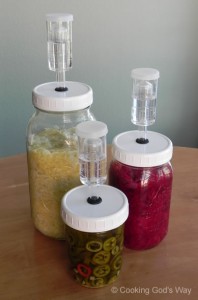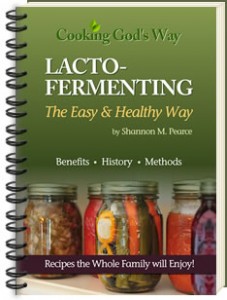Fermented vegetables like sauerkraut, pickles, and other fermented foods are often called lacto-fermented vegetables. Some people think that because the word “lacto” is used it must contain some form of milk or milk product, but this is not the case, most of the time.
Lacto In Lacto-fermentation?
This method of fermentation is called lacto-fermentation, because of the name of the microbe, lactobacillus, that converts sugars in the food causing it to ferment and produce lactic acid. Lactobacillus is naturally found on most raw vegetables and has nothing to do with lactose that is found in milk. What is even more exciting is that the lactobacillus bacteria that occur in lacto-fermenting help create lactic acid which inhibit or kill undesirable bacteria in food and in the human body. So in truth lactobacillus bacteria are “good-guys”.
of fermentation is called lacto-fermentation, because of the name of the microbe, lactobacillus, that converts sugars in the food causing it to ferment and produce lactic acid. Lactobacillus is naturally found on most raw vegetables and has nothing to do with lactose that is found in milk. What is even more exciting is that the lactobacillus bacteria that occur in lacto-fermenting help create lactic acid which inhibit or kill undesirable bacteria in food and in the human body. So in truth lactobacillus bacteria are “good-guys”.
What is really special about lactobacillus bacteria is that they grow in an enviroment that does not contain oxygen. This is beneficial because most harmful food bacteria requires oxygen to grow. When vegetables are fermented they are submerged in a brine solution (salt water). The salt helps to preserve the food until the lactic acid is produced in large enough qualities to preserve the food and eliminate the “bad bacteria” that could be on the food.
Yogurt and cheeses do have lactose and casein in them and people tend to call them lacto foods. This can create some confusion as lactobacillus bacteria are what makes milk form dairy ferments like yogurt and cheese. The thing to pay attention to is that the lactose and casein that can cause lactose intolerance is in cheese and yogurt because it is in the milk, not the lactobacillus bacteria that causes them to ferment. So lacto-fermentation does not impart lactose and casein into a food.
Hooray, lacto-fermented foods don’t contain lactose and casein unless it is there to begin with or you add it?
The Original Veggie Fermenter (starter kit).
Just add the food and a jar
Whey In Lacto-fermenting?
Some fermenting recipes out there call for a starter to be used. In some cases a starter must be used; we will mention that in a minute, but many lacto-fermenting recipes that don’t need a starter call for one. I feel this is because of two reasons; 1. People don’t trust the food to ferment on its own with its own bacteria, unless they add a starter. 2. I notice that many recipes that call for a starter just happen to sell the starter. Interesting…
 Whey is often the starter suggested in recipes to help kick start the lactobacillus bacteria by providing lots of them, but this is not needed since the vegetables already have all the lactobacillus bacteria on them needed to start the lacto-fermentation process. Keep in mind whey does have a taste that is like cheese; who wants vegetables to taste like cheese?
Whey is often the starter suggested in recipes to help kick start the lactobacillus bacteria by providing lots of them, but this is not needed since the vegetables already have all the lactobacillus bacteria on them needed to start the lacto-fermentation process. Keep in mind whey does have a taste that is like cheese; who wants vegetables to taste like cheese?
*Fermenting Fact: Cooked vegetables that are lacto-fermented, (hummus, bean paste, salsas, etc…) will have to use a starter and often this can be whey. These type of ferments have to use a starter since the cooking of the vegetables killed the lactobacillus bacteria that was naturally on them. This is the nature of the food item, since hummus is just cooked chick peas, which you can’t eat raw.
If you are lactose intolerant you do not want to eat a ferment made with whey, so steer clear of the recipes that call for a whey starter.
Lacto-fermenting Helps Vitamins and Minerals
Avoiding milk products because of lactose intolerance may help to keep the bloating, gas, and even diarrhea at bay. How much you avoid milk depends on how bad your level of irritation is with lactose. By avoiding milk and milk products to spare yourself the digestive issues, you are also avoiding a good source of calcium, vitamin D, and vitamin K.
Lacto-fermented food can help to put back some of the missing vitamins and minerals. What is wonderful about fermented foods is that during the process the tough cellular walls of the vegetables are softened making the vitamins and minerals more bio-available. It has been shown in studies that this can increase the amount of nutrition a food releases for digestion by more than double. Sauerkraut has been shown to deliver about 50 mcg of vitamin K2 a serving.
Make Fermented Food At Home – Easily
K2 Is Important For Bones
Vitamin K2 helps to allow the absorption of calcium in the body in a correct manner. In other words, the calcium goes to the bones and teeth where it is needed. This is important to all of us and especially seniors who, as they age, need bones to stay strong to avoid issues. Low levels of K2 allows calcium to be deposited in the soft tissues of the body, causing problems. Studies have shown that by increasing K2 levels in people that were deficient and dealing with hardening of the arteries, calcium was removed from the arteries allowing them to gain some flexibility back. Start fermenting foods today.
Enzymes Increased In Lacto-fermented Foods
Along with all the great vitamins and minerals that are released in lacto-fermented foods, enzymes are increased. Enzymes are found in raw vegetables, and they help our bodies to breakdown and digest foods. If you eat fermented vegetables along with cooked foods like chicken, the increased enzyme count in the lacto-fermented foods help your body to digest that enzyme dead food. Along with that better digestion of these cooked foods comes increased absorption of the vitamins and minerals of the cooked foods. I would call that a win-win!
Fermenting foods is easy! Are you doing it? Get everything you need to start here!


Speak Your Mind